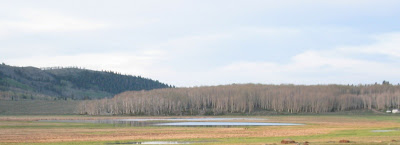studio, 32"x 24", oil, 'Aspens'
I live in the Rocky Mountains and the Quaking Aspens are one of my favorite trees. I love to ride my horse along the mountain trails with aspens. The locals call them 'Quakies' because the leaves of the aspens seem to be in constant motion. Aspens are med-sized deciduous trees. They like cold regions with cool summers at high altitudes. They have smooth pale greenish white to gray bark, marked with thick black horizontal scars and prominent black knots. The leaves are glossy green in summer and turn shimmering golden in the autumn. A painter's delight!
All of the aspens grow in large clonal colonies derived from a single seedling and are spread by means of root suckers. New stems in the colony may appear 98-130 ft from the parent tree. Some trees can live to be 40-150 years above ground, but the root system of the colony is long-lived. In some cases, this is for thousands of years, sending up new trunks as the older trunks die off above ground. For this reason, it is considered to be an indicator of ancient woodlands. They are able to survive forest fires, because the roots are below the heat of the fire, with new sprouts growing after the fire burns out.
All of the aspens grow in large clonal colonies derived from a single seedling and are spread by means of root suckers. New stems in the colony may appear 98-130 ft from the parent tree. Some trees can live to be 40-150 years above ground, but the root system of the colony is long-lived. In some cases, this is for thousands of years, sending up new trunks as the older trunks die off above ground. For this reason, it is considered to be an indicator of ancient woodlands. They are able to survive forest fires, because the roots are below the heat of the fire, with new sprouts growing after the fire burns out.
Less than 100 miles from where I live in South-central Utah is Pando (Latin for "I spread"), also know as The Trembling Giant, located in the Fish Lake National Forest, near Fish Lake at the western edge of the Colorado Plateau.
Pando is a clonal colony of a single male Quaking Aspen. The plant is estimated to weigh collectively 6,600 tons, making it the heaviest known living organism. The root system of Pando, at an estimated 80,000 years old, is among the oldest known living organisms, possibly the oldest living colony of aspens.
I snapped the above photo of Pando several years ago while painting in the Fish Lake area. I now have a greater respect for the Quaking Aspen. How about you?
I snapped the above photo of Pando several years ago while painting in the Fish Lake area. I now have a greater respect for the Quaking Aspen. How about you?



No comments:
Post a Comment